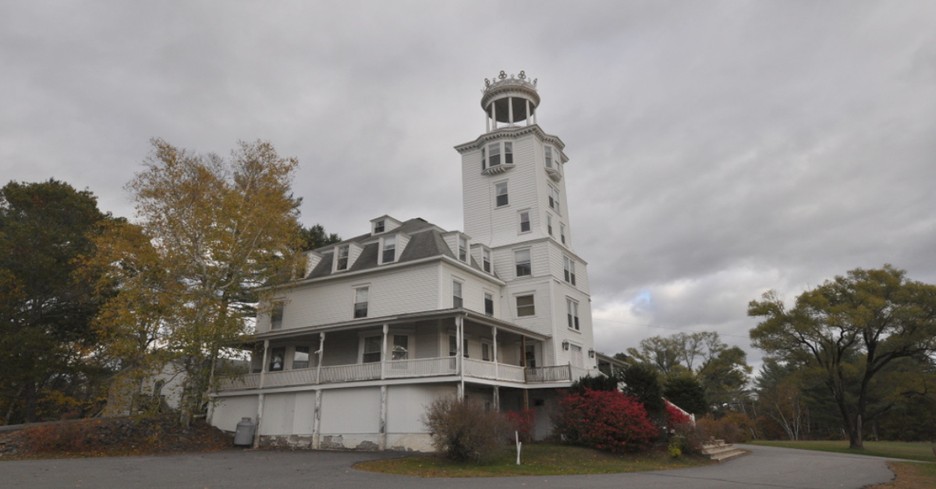
The image above is the Shiloh Chapel in Durham, Maine from Wikipedia
Early one morning in October 1911, maritime officials on duty at the harbor in Portland, Maine, stared with disbelief at a vessel slowly drifting toward them out of the mist. It took only a minute to identify the ship, the once-famous racing sloop Coronet.
Feared lost at sea for more than a month, suddenly there she was, appearing like a ghost of her once elegant self. Encrusted with barnacles, with shredded storm sails hanging from her masts, the yacht anchored at the medical inspection station and was boarded instantly by authorities, who hoisted the yellow flag of quarantine. On board they found deplorable conditions: sixty passengers, including women and children, in a space allocated for thirty, crowded into filthy, water-soaked quarters. The crew to a man were thin and haggard, some barely able to stand. "The worst cases of scurvy I have ever seen," the senior medical officer told the gathering reporters.
In a matter of days, a federal marshal arrested the owner of the vessel, the Rev. Frank Weston Sandford, charging him with the deaths of six of his crew. He had "unlawfully, knowingly and willfully" refused to provide a ship at sea with proper food and staples, read the indictment. Sandford pleaded not guilty. The tragedies had occurred in the process of obeying a "higher law," he told the court. He and his followers were carrying out the will and purposes of God for the end of the age and the triumphant return of Jesus Christ.
This story may seem all too familiar to modern readers--followers captivated by a deranged but convincing religious leader and led inevitably to disaster. But Sandford's organization was no backwoods parody, and Sandford himself, a graduate of Bates College, a respected young pastor, once a member of the highly acclaimed Student Volunteer Movement, had won the admiration of local and national Christian leaders and appeared to be headed for an important role in the church. So what went wrong?
A Chapel Called Shiloh
With an imagination like a magnet for the powerful stream of passions in the 19th-century church--perfectionism, world evangelism, end-time prophecy, and the messianic ideals of America itself--Sandford's ministry took a turn in the late 19th century, when God, he claimed, began to speak to him in whispers. The first word was "Armageddon," which he heard as a directive to establish a band of purified Christians, absolutely obedient to the Bible (as no other group or denomination yet was, he was convinced) to fulfill God's plan for the ages with "signs, wonders and mighty deeds."
He began this new work in southern Maine, with a tiny Bible school in a borrowed house. His first students, carefully selected men and women barely out of their teens, were to become the hardcore of the special "band." With funds "prayed in," the school expanded quickly. A complex of buildings soon arose on a sandhill in the farming town of Durham, with the first structure, a chapel, called "Shiloh." Though the movement labeled itself variously over time as the "Holy Ghost and Us Bible School," the "World's Evangelization Crusade," the "Church of the Living God," and finally "The Kingdom," "Shiloh" was the name that stuck.
Sandford's messianic vision also continued to grow, and he announced that he heard a series of God-whispered revelations naming him the present-day embodiment of the Old Testament David and the prophet Elijah returned--the restoration and completion of God's work throughout Biblical history. According to this vision, Sandford and his closest co-worker would be martyred for Christ on the streets of Jerusalem and rise again in three days, as predicted by the two witnesses in the Book of Revelation.
Within a decade of Shiloh's origin, the early party of students grew to many hundred, including whole families, sharing all things in common, in strict and uncompromising obedience to their leader. This was called the "hundred-fold" life. Money meant nothing and yet everything. Deliberately dependent on God for every necessity, as Sandford insisted, no one worked for wages. Nothing was sold. How then did they exist? Family savings were turned in as more and more people joined, funds were raised at conventions, and erratic farming provided some supplies. Very often there was not enough to eat, yet new stations were opened in Jerusalem and England, and sea craft was purchased to carry the Gospel around the world . . . which brings us back to the Coronet.
Shiloh's Brushes with the Law
The court case that followed the catastrophe at sea in 1911 was not Shiloh's first brush with the law. The "hundred-fold" life also rejected modern medical attention and looked to God for health and healing. In 1903, the death of a 14-year-old boy from diphtheria aroused public anger and brought Frank Sandford to trial for manslaughter in a case that dragged on for years. When he was finally acquitted of responsibility for the boy's death, he and a portion of his Shiloh company set sail for Jerusalem to await God's next orders. Those orders were for a select number to "circle the world for Christ" in the yacht Coronet. The idea was not to enter the land with the Gospel or with any humanitarian mission but to anchor offshore each of the continents and "break the power of hell" by a chain of prayer. Off they went on a treacherous journey in the tiny craft, crossing both oceans, rounding Cape Horn and the Cape of Good Hope. They sailed for four years before disaster struck.
In the course of this tremendous undertaking, Sandford learned that his legal troubles were not over. While the Coronet sailed, authorities watched for him at ports of call with a writ for his arrest. The alleged offense was a relatively minor one, but he feared its resolution would mean a serious interruption to the yacht's mission. To avoid being tracked, he refused to enter ports to obtain provisions. As the "Coronet Company" rode out gale after gale in the North Atlantic, six men died of scurvy and malnutrition and a strong remnant of the crew insisted on being brought to shore. After the yacht finally limped into the Portland harbor, Frank Sandford was convicted of manslaughter and sentenced to ten years in federal prison.
Shiloh Goes Underground
With the crusade on hold, while their shepherd lived out his sentence, the Shiloh "flock" patiently endured hardship (and a World War) on their property in Durham, Maine. When he returned, haunted by death threats, Sandford moved with his family and most trusted workers to another property in Boston. It was during that time, while the Boston contingency fared well, that starvation took over in Durham, where "the Holy Ghost had been dethroned by a failure of faith and obedience," as Sandford claimed. These hard times led to a third major court trial in 1920, one that involved no charges against the leader himself, but against a follower in Durham accused of allowing his children to go hungry, a father who--true to the "hundred-fold life"--refused to work for wages. Faced with the possibility that the courts would require all heads of households to seek gainful employment, Sandford received new instructions from God--quite simply, "Work." For many of the men, this meant moving to other parts of the country. The Durham property quickly shut down, and Shiloh went "underground."
Frank Sandford died in1948 at the age of 87, in a comfortable farmhouse in Hobart, New York, surrounded by his family and faithful disciples. He died of old age, not hunger or hardship or martyrdom. For another half-decade, Shiloh carried on as The Kingdom, Inc., with headquarters in New Hampshire and pockets of followers throughout the country. It exists today as a decentralized evangelical movement, with the memory of its founder and shepherd still revered.
Is Shiloh A Cautionary Tale?
What are we to draw today from such a history? Is it only a cautionary tale about the risks in following a deluded and self-exonerating leader? Apart from that, what can be wrong with a yearning for uncompromising faith, or with a willingness to give up all to see God’s Kingdom realized on earth, or obedience to God in the face of severe challenge? For these very qualities, we have honored our Christian heroes through the ages. At the conclusion of her history of the Shiloh movement, Fair, Clear and Terrible, author Shirley Nelson points to the snare of needing and insisting on answers, of “knowing” with certainty God’s will and plan for the world—of reading that plan INTO Scripture and going to extremes to carry it out. This, she suggests, is obedience not to God but to our own ideas and theories, an insidious and dangerous form of idolatry for leaders and followers alike.
Parham Came and Left
When did the Pentecostal movement begin? Many trace it to a 1906 revival on Azusa Street in Los Angeles, led by the preacher William Seymour. But some would go back further, to a minister in Topeka, Kansas, named Charles Fox Parham. Seymour had studied at Parham's Bethel Bible School before moving on to his own ministry.
Parham preached "apostolic faith," including the need for a baptism of the Holy Spirit accompanied by speaking in tongues. A revival erupted in Topeka on January 1, 1901, and many were convinced that the turn of the century had brought them into the last days.
A year earlier, Charles Fox Parham had visited the Holy Ghost and Us School at Shiloh, run by Frank Sandford. While Sandford's teaching was not entirely Pentecostal, it did share many features with Parham's emerging theology. In fact, Parham started the Bethel Bible School shortly after returning from the Shiloh trip, apparently modeling it on Sandford's institution.
Postscript:
This issue was written by Shirley Nelson. Her parents grew up as part of the Shiloh community. Shirley is also the author of the most definitive study of Shiloh and Sandford, entitled Fair Clear and Terrible: The Story of Shiloh (British American Publishing, 1989). The book is out of print but a new edition may be issued soon. It should be required reading for seminary students, as it insightfully reveals various recurring pathologies among religious leaders.
See the website fwselijah.com and its valuable documents and dialogue. It also reports on the current remnant. We are told:
The church fellowship found today at Shiloh Chapel, Durham, ME, is currently disentangling itself from the Kingdom. It (Shiloh) is now an independent corporation, and its ministry is focused on Christ alone. The Holy Spirit, through the current ministry team, is working to bind up the confusion and wounds which resulted from a ministry not totally centered on the Christ's gospel. Though Shiloh's roots spring from the soil of Sandford's quasi-Biblical doctrines, they, as individuals and as a unified church, are today earnestly seeking their role in the expansion of God's Kingdom on earth.

.jpg)
